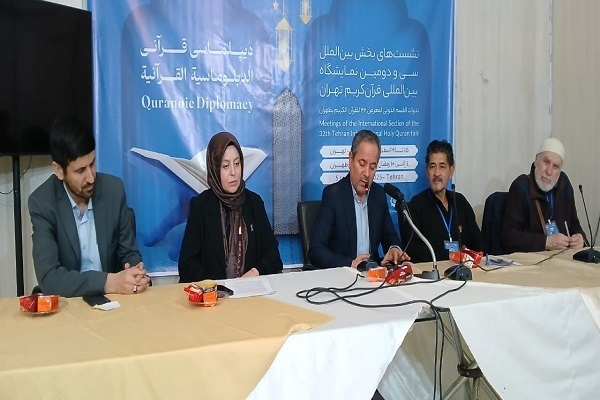Experts Highlight Need to Train Young Talents in Quranic Calligraphy

Several calligraphers addressed the forum titled “The Need for Synergy Among Contemporary International Quranic Institutions,” which was held on Saturday on the sidelines of the 32nd Tehran International Holy Quran Exhibition at the Imam Khomeini Mosalla.
Attendees included artists and calligraphers from Iran, Turkey, Thailand, and Algeria.
Among the speakers were Mohamed Ben Qanif, an Algerian calligrapher and president of the Algerian Calligraphy Association; Qader Perdapyat, a Thai Quranic calligrapher; Hulya Asan, president of the Turkish cultural and Quranic institute "Çoku Anbar"; and Morteza Tavakoli, director of Iran’s Center for Quran Printing and Publishing.
Calligraphy as a Pillar of Quranic Arts
Opening the session, Mohamed Ben Qanif praised the organizers of the Tehran International Quran Exhibition, stating, "This significant Quranic event reflects the Islamic Republic of Iran’s commitment to the Quran."
The Algerian calligrapher stressed that Quranic calligraphy traces its roots to the early scribes of revelation during the Prophet Muhammad’s (PBUH) era. "I am not a specialist in Quranic sciences, sociology, or politics, but as a calligrapher, I believe that the art of writing the Quran is an integral part of our religious heritage."
Read More:
Ben Qanif called for greater collaboration among Quranic institutions to support calligraphy. "Gathering Quranic calligraphers and artists fosters unity in this field. This initiative serves the words of God, strengthens solidarity, and helps prevent division and discord."
He proposed launching an international Quranic calligraphy competition. "Currently, organizations such as the Research Center for Islamic History, Art, and Culture (IRCICA) in Turkey and institutions in Algeria hold calligraphy contests. However, a global competition featuring top calligraphers would be highly beneficial."
Quran as a Source of Art and Wisdom
Hulya Asan, a Turkish calligrapher, described the Quran as a fusion of wisdom and art. "The Quran is a source of mercy and guidance for humanity. Its light has illuminated souls throughout history, manifesting aesthetically through the hands of artists. Islamic arts such as calligraphy, illumination, pottery, and architecture all draw inspiration from the Quran."
"The Quran teaches us to think and act as one nation, accepting differences as strengths. Like the soul of an ummah, art unites diverse geographies, cultures, and languages, becoming a powerful medium for bringing people together," she said.
She highlighted the unifying power of Quranic-inspired art. "Islamic calligraphy on mosque domes and illuminated Quranic pages exemplifies the Quran’s ability to connect people through art."
Read More:
Thai calligrapher Qader Perdapyat praised the Quran exhibition and expressed interest in bringing similar events to Thailand. "We do not have such gatherings in Thailand, but we are eager to introduce this idea."
Perdapyat, who specializes in Quranic calligraphy on wood, donates proceeds from his artwork to support orphans.
"I was deeply inspired when I saw non-Muslims appreciating the beauty of calligraphy. This motivated me to dedicate my art to the Quran," he said.
Printing One Million Copies of the Quran
The final speaker, Morteza Tavakoli, provided historical context on the transcription of the Quran, noting that its written tradition dates back to the time of revelation.
"Today, many Islamic countries, from North Africa to Southeast Asia, are engaged in Quran printing," he said.
Tavakoli highlighted Iran’s contributions, stating, "Following the Islamic Revolution, the Center for Quran Printing and Publishing was established under the directive of Ayatollah Khamenei. Since its inception, the center has successfully printed ten handwritten Qurans and has produced over one million copies."
4270583
Reporting by Mohammad Ali Haqshenas



